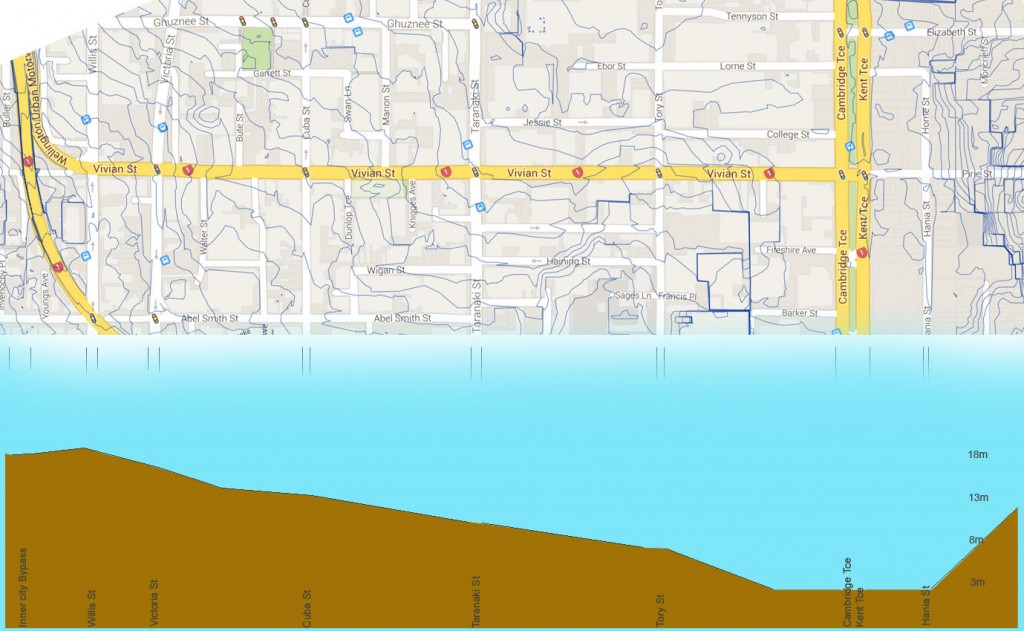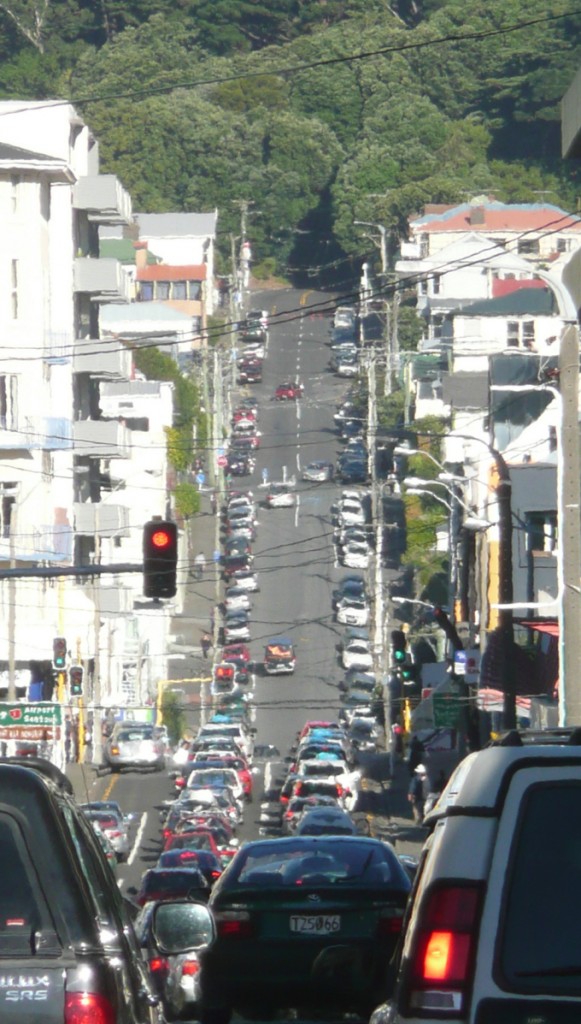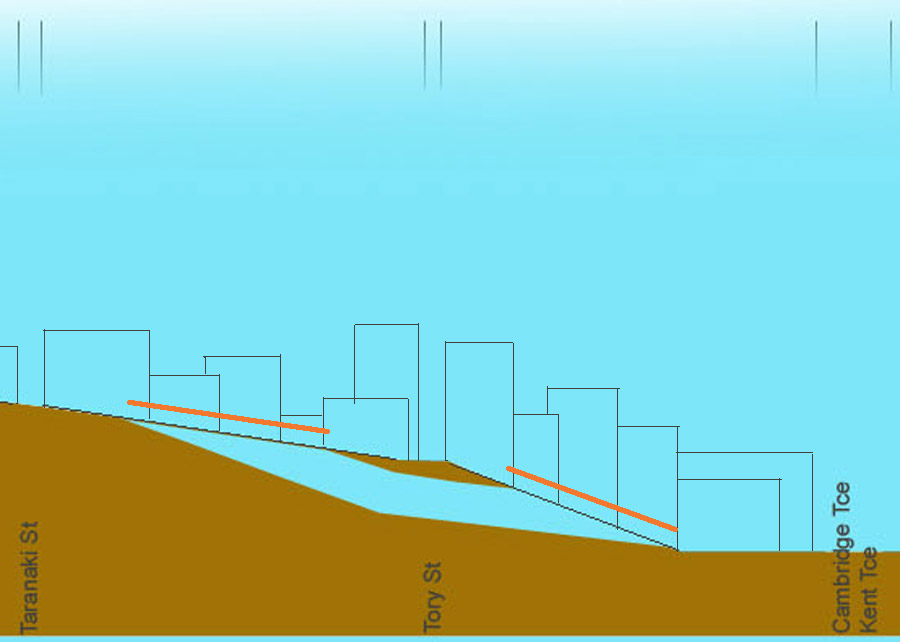I’ve been thinking about a comment I made, that Lindsay Shelton picked up over on Scoop, where he was talking about what “one of Wellington’s leading bloggers“ had said. Ahem. I had noted that “I think we need to start exploring the concept for a trench at least in parts along Vivian St, as 3 lanes at ground level there is just going to be horrific.” And so I now feel honour-bound to explore that. Is it feasible?
Well, there’s no doubt that it physically could be done, but would anyone ever want to do it?
Let’s look at what it would entail. Here’s a map of Vivian St, including the 1m contour lines. What it doesn’t show is the services. But you know the street – pretty much slopes downhill all the way, across town.

Money, especially in undergrounding a main urban road like this, is the biggest issue of all. If they couldn’t afford to put the whole of Karo Drive underground, as arguably they should have, then it is going to be all that much more harder and totally impractical due to expense here. It’s the shifting of underground services that’ll kill off any such talk.
But are there any alternatives? While nearly every pedestrian on the planet (OK, in Wellington) would like, is for the incessant traffic of Vivian St to go away, or be underground, out of sight (or out of site!), what is most important is the pedestrian routes north and south – if they could be made accessible, instead of having to wait for the lights, then that would be great. Pedestrian routes in this part of town all predominantly run north-south – so that includes, Willis, Victoria, Cuba, Taranaki, Tory, Cambridge and Kent. Phew – that’s quite a few! Let’s have a look at that in a long section – exagerated for height, obviously, but drawn out reasonably accurately based on the contour lines above.

We can see that the route of Vivian St is, as we know, a bit of a roller coaster. This long telephoto shot indicates the nature of the beast:

It seems from that picture, that there is room to tunnel under in some spots. I guess that one option is just to trench down all along the route, but then the poor harassed business owners along V St will be completely out of touch with their passing roadway. They have a hard enough time as is. But there are a couple of places that one could slip in an underpass: right at the top, to slip under Willis and Victoria (which would greatly aid the people from Brooklyn who want to get to the rest of Wellington). The other, and it is pushing it here, is under Tory St.

Yes, I know – the angle of the road works out OK (but only just – it is a little steep), but the top of Vivian St can work out all day long – if NZTA wanted to. I’ve noted previously that they have deliberately left it so that can be an option at a later date.
At the Tory St “underpass” this would mean that there is no room for turning left or right off Vivian and onto Tory. While that would be good for cyclists and pedestrians on Tory (which looks like it will just get more and more popular as a foodie location), it is not that good for businesses that want to get their goods to the door in Tory. Have a look at this enlarged section by Tory St – the orange line indicates the amount of businesses that will have a trench in front of their building – and potentially only a skinny footpath as a frontage. Not that nice…. but arguably / possibly nicer than having a 3-lane motorway going past your front door?

Of course, the biggest hold up on Vivian St is the junction with Taranaki St, but there is no point trying to sweat that – it will always be needed as a interchange point. As is Cambridge/Kent Tce junction – it’s a major interchange, and traffic banks up there. As the main route from SH1 to the airport and therefore the major clashpoint with north-south traffic is either Taranaki or Cambridge/Kent, then this is a potential future sticking point as well. The only other option would be a bridge of traffic over Cambridge/Kent, and that would look something like this:

Don’t think it hasn’t been thought about yet though – my guess is that there is a consultant’s draw with a proposed scheme for an overbridge here, just waiting to go ahead…





How about we just ban cars. Cheaper, and more convenient.
I’ve given Fulton Hogan enough of my money. If they want more, they’ll have to beg.
Why Vivian Street? Wouldn’t it be cheaper/flatter/drier to underground along the Inner City Bypass/Karo Drive route? Put 2 lanes in a covered trench under/alongside Karo/Arthur/Buckle?
George and Chico – both of you – very good points indeed. Certainly, makes more sense to underground the whole of Karo Drive, than to try and do the whole of Vivian – my argument is that at the very least, if they continue with Vivian as the main through-route, then it needs work. The top works better and is doable (re-route traffic down Ghuznee, where it used to be) while they dig up the junction with Vic and Willis.
The junction with TORY – VIRTUALLY IMPOSSIBLE I THINK, AND SO THAT’S JUST NOT GOING TO HAPPEN. ooops, caps lock on….
I agree with George. Plant trees down Vivian Street and make it into a park.
I agree as well, but it isn’t going to be easy. What we need to do is to force NZTA to recognize that, long term, the use of Vivian is not sustainable and so that they therefore need to develop buckle St as a two-way, trenches, underground thoroughfare. Starting now. Their current work on “traffic improvements” on Karo Drive is just making things way, way worse.
You couldn’t practically trench Vivian St. It is just too narrow. People would have significant construction work happening just a meter or two from their buildings, there really isn’t any room to move the bulldozers and huge cranes, and there is a danger of undermining the foundations of the buildings.
It makes much more sense to make Karo Drive two way, like it should always have been. Put as much as you like underground. I’ve said before that the new War Memorial trench should have had a parallel trench constructed next to it to allow for this to happen in the future. Then, Vivian St would be more like a normal inner-city street… you could even make it two way, and there would be less need for vehicles to make a rat run through Courtney Place in the Cambridge to Taranaki direction.
As elegant as some of the ideas around Karo Drive might be, they’re a solution in search of a problem. Traffic volume increase in the last decade: -3.5%. The easiest answer to all these alleged traffic woes is the simple one – do nothing. At this rate of decline, congestion will solve itself without a dollar spent by around 2030.
Kent… Why assume that we’re trying to “solve” congestion? I think we should be aiming to improve Te Aro, remove some constraints to growth in Wellington, and add some redundancy so that we’re able to move around after an earthquake. Also, the fact that people put up with shite in the past is no excuse for forcing them to keep putting up with shite. People expect modern efficient infrastructure and services these days.
Reducing traffic volumes is a pointer to a stagnating city. Rather than saying “that’s great news, the stagnation means we won’t have to build new infrastructure”, I’d rather than we took measures to develop a growing city economy.
If I could head off on a tangent… What is happening down at Taranaki St Wharf? Is the blue sheeting supposed to be the “baffles” that will deflect the poo away from the jump platform out in to the harbour, or is there more work to come? If the blue sheets are the solution, then why did it take over a year to install to install them? Why can’t we just stop pumping sewerage in to the harbour?
According to the news, 26 January last year was the day when the harbour was tested and found to be more polluted than the Ganges. It was a sunny Saturday, and I happen to have snapped a few photos of the jumpers as I passed. They were unaware that they were diving in to a toxic soup of sewerage. One was a bride out on her hen’s party. It’s all quite horrible, actually.
davidp – You’re entirely right, of course … there would be ample scope to improve the urban environment if there was a more considered approach to how and where roads were run in the city. However there’s only one minor technical hitch: this has never occurred in the past, and while the current crop of traffic engineers are ensconced at WCC and GWRC and NZTA, it will never happen in the future.
In this country, building (or changing) roads is always done with the sole objective of speeding up traffic, using the long-discredited “predict and provide” approach that was abandoned 30 years ago in the rest of the world. And even when there are some nods in the direction of an improvement to the urban environment, the positive changes never manage to make their way from the drawing board to real life.
Karo Drive is a prime example. There’s no argument that it’s a no better urban environment than the Te Aro that preceded its construction – in most respects, it’s vastly worse than the neighbourhood that was demolished. The experience is worse for pedestrians, residents, cyclists … basically anyone who isn’t in a car and headed for SH1. So that’s the downside of the Inner City Bypass project.
The trade-off for a significantly worse Te Aro was meant to be that the Quays would be reduced to four lanes, so that the urban environment along the waterfront would be improved. To state the blindingly obvious, this never happened. Asking an NZ traffic engineer to give up roading capacity in favour of a better city is effectively impossible – they will cling to that extra lane with the dogged determination of a Goldman Sachs banker hanging onto their last bonus dollar, even as traffic volumes drop and oil prices rise and the climate goes crazy.
So despite the appeal of trenching roads to improve the city, I think it would only work in one circumstance – the traffic engineers would need to be kept as far away from it as possible.
Davidp I understand that there are to be showers installed to wash the poo off that gets through the “baffles”
Pauline… There is a shower there now, installed on the side of the ambulance hut.
I’m still interested why the actual problem can’t be fixed. Find the leak. Stop it. You shouldn’t be dumping sewerage in to the harbour 100m from our national museum. Or any other part of the harbour, for that matter.
David, check Wellington Scoop re state of harbour under the heading “Too much copper, lead, zinc and mercury found in inner harbour”
Also back in 2000 Bruce Green then CEO of Lambton Harbour (now WWLtd) sent a report to Wellington City Council re contaminants in the Taranaki Street Wharf and lagoon area…..so what’s new?
Part of the problem stems from the fact that in the CBD/Te Aro, there are private sewer laterals connected to the public storm mains.
Is there a cheap/easy solution? No. Should council tackle it? If they want the public/tourists to have a safe, enjoyable, pleasant waterfront – absolutely.
The problem along Vivian St and in the central city is that the W C C gave State Highway 1 over to N Z T A in order to save money and have N Z T A contribute to costs. Instead N Z T A took control of SH ! and the result is obvious.
This is a Government Dept., out of control, People, livelihoods, quality of life, Nature, heritage, – Esoteric, not considered.
Ellie: WCC never “gave” Vivian St to NZTA to save costs – the then Transit NZ took it in order to make a more logical State Highway set-up in Wellington, entirely reasonable in that respect. WCC had no say except as a consultee at the time.
What no-one foresaw at the time is that the roading authority would take such a one-eyed approach, basically ignoring everything except the flow of through traffic, bullying its way through.
A case study in the misuse of state power, unfortunately.
from the Coroner’s report on the fatal crash at Karo Drive:
http://www.stuff.co.nz/dominion-post/news/9945900/Crash-site-incompatible-with-motorway
“Wellington City Council transport portfolio leader Andy Foster said the only way to stop major roads intersecting the bypass would be to put it underground. There had been discussions with central government about this, both in the 1990s and more recently, but cost was a major barrier.
“It’s not something that’s going to happen in our lifetime.”
NZ Transport Agency regional performance manager Mark Owen said safety improvements were under way on the bypass. More visible traffic lights, high-friction surfacing, speed-limit reductions and red-light cameras were all being implemented or investigated.”